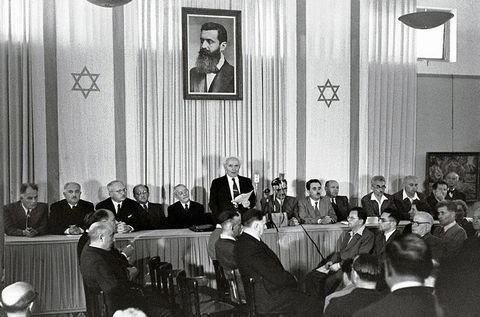War of Independence 1948
On November 29th, 1947, the United Nations General Assembly voted to partition Palestine. Immediately after the vote, the first Arab attack was launched in Jerusalem, and it did not take long before the fighting spread throughout the country. When Britain made it clear that their mandate would end on May 14th, 1948, and that they would withdraw their forces by then, the surrounding Arab countries stated that if the Jews declared independence, they would immediately invade the country to prevent partition.
While the armies of seven countries amassed on Palestine’s borders, 37 Jewish leaders signed the declaration of the State of Israel, and on May 14th, 1948, David Ben-Gurion read out the declaration as follows –
Declaration of Independence May 14th, 1948
“The Land of Israel was the birthplace of the Jewish People. Here their spiritual, religious, and political identity was shaped. Here they first attained statehood, created cultural values of national and universal significance and gave to the world the eternal Book of Books…And thus we the members of the Peoples Council, representatives of the Jewish community of the Land of Israel and the Zionist Movement, are here assembled…to declare the establishment of a Jewish State in the Land of Israel, to be known as the State of Israel.”
Only a few hours passed before the Arab armed columns advanced upon the fledgling State, from the south, the east and the north. After 1878 years, when Roman armies destroyed the Temple in Jerusalem, Jews were again fighting for their independence.
Despite the fact that the Arab forces were better equipped and significantly larger than Israel’s, they were uncoordinated and disorganized, with the exception of the British trained Arab Legion from Transjordan, as opposed to the Jewish fighters who, despite their relatively small numbers, were organized, disciplined and well trained and included a large number of World War II veterans from around the world.
At the start, it was the Arab armies that took the offensive, causing severe casualties to the Israeli forces. However, the Haganah then took the initiative and within six weeks had captured the Arab sections of Tiberias and Haifa and later Safed and Acre (Akko) and gained control of much of the territory allocated to the State of Israel under the Partition Plan. On May 31st, 1948, the Haganah was renamed the “Israel Defense force.”
By January 1949, Israel had taken control of an area significantly larger than that designated by the United Nations, and this remained Israel’s territory until 1967. The areas remaining in Arab hands were Gaza held by Egypt. The area of the west bank and the old city of Jerusalem, including the Western Wall and Solomon’s Temple, upon which the Muslim Dome of the Rock had been built, were in the hands of Jordan. All the surrounding Arab States signed armistice agreements except for Iraq, who withdrew its forces and handed over its positions to Jordan.



